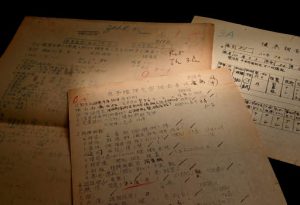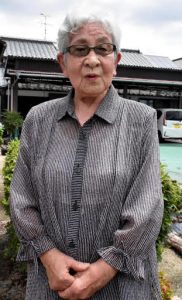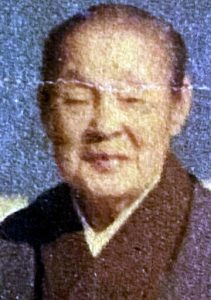Striving to fill voids in Hiroshima, evidence of victims remains 76 years after atomic bombing—Medical charts in aftermath, Part 2: Kyoto University materials
Jul. 31, 2021
Daughter remembers mother after seeing column describing clothing
Memories are passed on after victim’s records disclosed to family
by Kyosuke Mizukawa, Staff Writer
A piece of yellowed paper is titled “Atomic bomb damage survey items,” listing nearly 50 questions about the circumstances in which respondents experienced the atomic bombing as well as their health status. The respondents were asked details about not only the extent and site of burns and injuries but also about the clothing they had worn and whether there was any shielding nearby when they experienced the bombing. The survey items included other meticulous questions about symptoms the respondents might have suffered such as bleeding, fever, and hair loss, which are now known as acute symptoms of radiation exposure.
Total of 9,000 people surveyed
These “Kyoto University materials” are records from an A-bomb survivor health survey initiated by researchers at Kyoto University’s Faculty of Medicine in September 1945. The survey work was continued until 1949 based out of the Ono Army Hospital (now part of Hatsukaichi City) and Ushita National School (now Ushita Elementary School, located in Hiroshima’s Higashi Ward). Those surveyed totaled around 9,000 people, with more than 10,000 survey forms generated and archived in the form of hard-copy documents.
Akiko Kubota, 51, assistant professor at Hiroshima University’s Research Institute for Radiation Biology and Medicine (RIRBM; located in Hiroshima’s Minami Ward) who is in charge of archiving the survey forms, is able to sense from the individual forms the difficulties faced by the researchers who tried to understand the unknown damages caused by the atomic bombing, as well as the existence of A-bomb survivors who answered the questions in the survey. Ms. Kubota said, “There are survey forms that young children filled out by themselves. I grieve when thinking about their situation after the atomic bombing.”
Earlier in the spring this year, Ms. Kubota displayed the Kyoto University materials at a special exhibit commemorating the 60th anniversary of the founding of RIRBM, with the aim of conveying the records broadly to the public. The displayed forms included descriptions of people who “started feeling sluggish on August 6” or were “wounded by shards of glass.” To protect the personal information of respondents, names were omitted from the materials.
Assuming that the survey respondents with names listed in the Kyoto University materials or bereaved family members might wish to take a look at the survey records from that time, the Chugoku Shimbun looked for people who might have responded to the survey, based on a variety of personal notes related to the atomic bombing. As a result, we discovered the name of Kane Obara, who received medical care in the Ushita area after experiencing the atomic bombing but died at the age of 88 in 1979. We asked Hisako Onoda, 93, Ms. Obara’s seventh daughter living in Okayama City’s Kita Ward, about whether she had the desire to see her mother’s records. Ms. Onoda responded, “If information about my family is available, I’d very much like to see it.”
We prepared documents describing Ms. Onoda’s wishes and consulted with Ms. Kubota, who checked whether or not Ms. Obara’s records had been archived. A total of six survey forms from two surveys were subsequently found. The first survey form is dated September 10, 1945, but no specific date is indicated for the other form from 1946. We snapped photographs of the original forms and showed them to Ms. Onoda.
“It really is my mom’s information,” said Ms. Onoda, as she looked at the name “Kane Obara” on the survey forms. She removed from her pocketbook a photograph of her mother that she always carries with her. When she saw the word “Kantan-fuku” (which means a loose summer clothing) in the survey’s column used to describe clothing that respondents wore at the time of the bombing, she remarked, “Yes, yes,” apparently retracing memories of her mother.
Burns on face and arms
Their home was located in the area of Kamiyanagi-cho (now in Hiroshima’s Naka Ward), about 1.5 kilometers from the hypocenter. Ms. Onoda said, “An air-raid alert went off in the morning. It was a hot summer day, but my mother and I wore long-sleeved clothing in preparation for possible air strikes. As the alert was called off, though, we took off our long-sleeved shirts and stripped down to the loose clothing. Shortly afterward, there was a flash.” Her mother, Ms. Obara, was exposed to the thermal rays from the bombing when she was carrying firewood near the house and suffered severe burns on her face and arms.
Sukeichi Obara, Kane’s husband who was then 62, was killed in the bombing while he was outside the house. Ms. Obara fled to her eldest daughter’s home in the area of Ushita, but as no medicines were available, her family grated unripe persimmon and placed the mix on her burns. In the column titled “burn injuries” in her survey form dated September 10, 1945, are written the descriptions “Scale: Second-degree” and “Site: Face and arms.” The other form from the following year’s survey recorded that it had taken two months for the burns to completely heal and that scars remained on her skin.
Ms. Onoda said, “The skin on her arms grew taut and looked painful. My mother was a strong-minded woman, though, and so she was more worried about me than about herself.” She had pieces of glass stuck in her body and suffered severe injuries near her eyes. Even after her daughter moved to Okayama City because of marriage, Kane was concerned about her daughter’s health and frequently visited her from Hiroshima.
The Kyoto University materials are representative examples of a large-scale survey conducted in the aftermath of the atomic bombing. If those who were surveyed or their family were to be able to view the survey forms, they would be able to reflect on the conditions of that time in detail, while researchers would be able to obtain facts not included in the survey forms from the family members of survey respondents. After the atomic bombing, 76 years have passed, but there still remains work to be done with regard to such A-bombing materials.
(Originally published on July 31, 2021)










